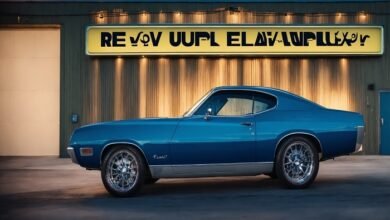Car-34: Revolutionizing Urban Mobility

Introduction
The Car-34 model represents a significant leap in urban transportation technology, combining eco-friendliness with state-of-the-art features designed for city life. As cities become more congested and pollution levels rise, the Car-34 offers a sustainable solution that meets the needs of modern urban dwellers. In this blog post, we will delve into the various aspects of Car-34, exploring its design, technology, environmental impact, cost-effectiveness, and much more.
Innovative Design and Features
The Car-34 isn’t just another vehicle; it’s a testament to innovative automotive design. With its compact frame, the Car-34 is perfect for navigating narrow city streets and tight parking spaces. This section examines the ergonomic design, the use of lightweight materials, and the advanced safety features that set Car-34 apart from traditional vehicles. Each feature is thoughtfully integrated to enhance driver and pedestrian safety while ensuring a comfortable and enjoyable driving experience.
Advanced Technological Integration
Technology is at the heart of Car-34, making it smarter than ever. From autonomous driving capabilities to an advanced navigation system that integrates real-time traffic updates, Car-34 uses technology to make urban commuting less stressful. This segment discusses how the Car-34’s technology adapts to various urban environments, enhancing connectivity and accessibility for all users.
Eco-Friendly Engineering
One of the most critical aspects of the Car-34 is its commitment to sustainability. Powered by a fully electric engine, Car-34 not only reduces emissions but also decreases noise pollution, contributing to a cleaner and quieter urban atmosphere. Here, we’ll explore the environmental benefits of adopting Car-34, including its energy-efficient engine and the use of recycled materials in its construction.
Cost-Effectiveness and Economic Impact
Investing in a Car-34 isn’t just about owning a vehicle; it’s about making a long-term economic decision. This section covers the cost benefits of owning a Car-34, from tax incentives to lower maintenance costs, and how it compares financially to traditional combustion engine cars. Additionally, we’ll discuss the broader economic impact of widespread Car-34 adoption, such as reduced healthcare costs due to cleaner air.
User Experience and Accessibility
The Car-34 is designed with the user in mind. This part delves into the user-friendly interface, accessibility features, and customer support that Car-34 offers. We will discuss how these features make Car-34 an excellent choice for people of all ages and abilities, focusing on the intuitive design that ensures ease of use for everyone.
Safety Protocols and Ratings
Safety is paramount in the design of Car-34. In this section, we evaluate the safety measures integrated into the Car-34, including collision avoidance systems and emergency response features. We will also look at the safety ratings awarded to Car-34 by various automotive safety agencies and what these ratings mean for potential users.
Impact on Urban Planning
The introduction of Car-34 has implications beyond just transportation. This segment examines how Car-34 could influence urban planning and development. We will explore potential changes in infrastructure, such as reduced need for large parking lots and the possibility of new green spaces, as cities adapt to a higher presence of compact, electric vehicles.
Regulatory Considerations and Challenges
With any new technology, regulatory challenges must be addressed. Here, we discuss the regulatory landscape that Car-34 navigates, including the standards and policies affecting electric vehicles. This section also covers the hurdles Car-34 faces and how they are being overcome to pave the way for cleaner, more efficient urban transport solutions.
Market Response and Consumer Feedback
Since its launch, the Car-34 has received various feedback from users and industry experts. This part of the blog evaluates the market response to Car-34, including sales data and consumer reviews, highlighting areas where it excels and where there is room for improvement.
Future Prospects and Innovations
Looking forward, the Car-34 is set to evolve further. This final section speculates on future updates and potential new features of the Car-34, exploring how it will continue to lead as an example of innovative urban transportation. We will also consider upcoming models and what they could mean for the future of city commuting.
Conclusion
The Car-34 stands out as a pivotal development in the evolution of urban transportation. With its focus on technology, sustainability, and user accessibility, it offers a comprehensive solution that addresses many of the current challenges faced by city dwellers. As we move towards more sustainable living environments, the Car-34 represents a significant step forward in making our cities healthier, safer, and more efficient places to live.
FAQs
- What makes Car-34 different from other electric vehicles on the market? Car-34 integrates superior design with advanced technology, offering features specifically tailored for urban living, such as compact size and enhanced maneuverability.
- How does the autonomous technology in Car-34 enhance safety? The autonomous driving technology in Car-34 includes sophisticated sensors and AI algorithms that detect potential hazards and react faster than a human driver, significantly reducing the risk of accidents.
- What are the environmental benefits of driving a Car-34? By using electric power, Car-34 eliminates tailpipe emissions, reducing air pollution and helping to combat climate change.
- Is Car-34 affordable for the average city dweller? Yes, when considering the lower operational and maintenance costs, as well as potential tax incentives for electric vehicles, Car-34 is an economically viable option for urban residents.
- How will Car-34 impact urban traffic conditions? With its compact size and advanced navigation systems, Car-34 can help reduce traffic congestion and improve overall traffic flow in urban areas.




